78 Search Results for object symbols
March 23, 2013
by Robin Parker -
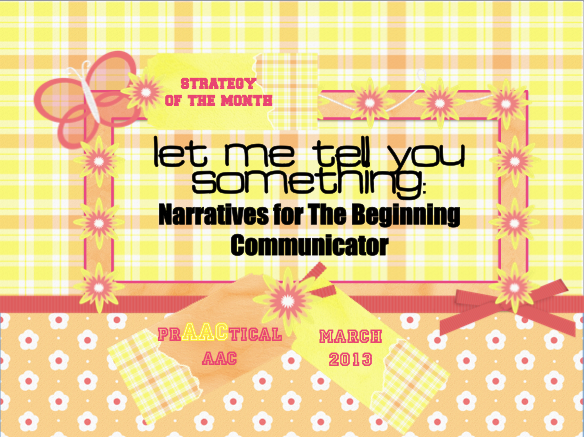
March continues with story telling or narratives as the Strategy of the Month. All learners have stories to tell but some may need special teaching to be able to express their stories. Goals for the beginning communicator can and should include narratives. Personal narratives are a good place to begin but any type of narrative can be taught with structure, routines, partner support, prAACtical strategies. Robust communication includes story telling. Yes, beginning communicators need to be able to express wants and needs however, authentic and comprehensive language involves much more. The quicker we start teaching, the quicker beginning communicators (or anyone) can learn. Beginning Communicator Narratives 3 Types (Just some of the options) Remnant Books are a visual and tactile way of telling stories by recording important events. Learners can help choose items from meaningful personal experiences which serve as a reminder of stories to tell. Create routines and visual supports... [Read More...]
March 14, 2013
by Carole Zangari -
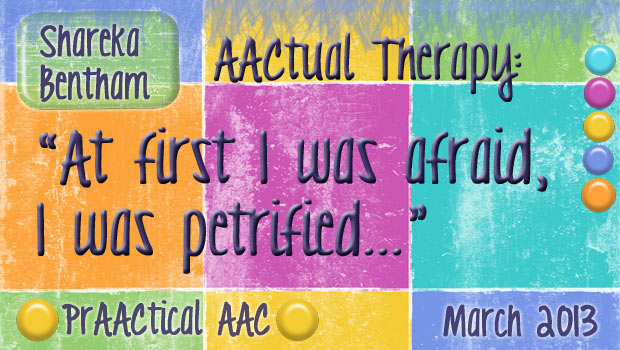
We’re back to share more from SLP Shareka Bentham whose enthusiasm for providing AAC services to children in Barbados is infectious. If you’ve read any of her previous posts, you’ll know why we appreciate her perspective. Today, Shareka shares some of what she’s learned through starting AAC groups. Groups can be daunting for many Speech & Language Therapists. They sure were for me for many years. So to make the decision to start an AAC group was more than out of my comfort zone, especially as a beginning AAC therapist. However I think that it has been a great decision so far, as the changes that I have been seeing in the children, parents, and in myself as a therapist have been extremely encouraging. As I keep stressing I am by no means an AAC expert, but I’m an expert in reflection. I have been able to review each... [Read More...]
March 7, 2013
by Carole Zangari -
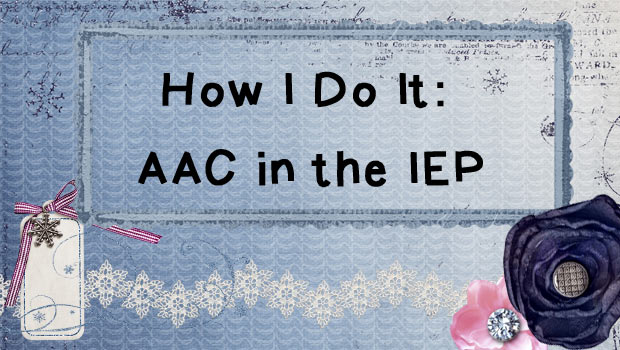
We’re happy to welcome back, Lauren Enders, an AAC specialist from Pennsylvania. You can read her earlier post here. This month, Lauren shares some of ways she addresses AAC learning in the IEP. Frequently, SLPs and teachers contact me in a complete panic because they need to generate an IEP and write IEP goals for a student who is using (or beginning to use) Augmentative and Alternative Communication (AAC). These folks have lots of questions and most often, have no idea where to begin. There are a number of questions that come up repeatedly in these panicked requests. When approached by PrAACtical AAC to write a post about IEPs and AAC, I thought it might be helpful to share some of the most common questions I hear along with the answers I provide. I will structure the post in a Question & Answer format in the hopes that the post... [Read More...]
February 14, 2013
by Carole Zangari -
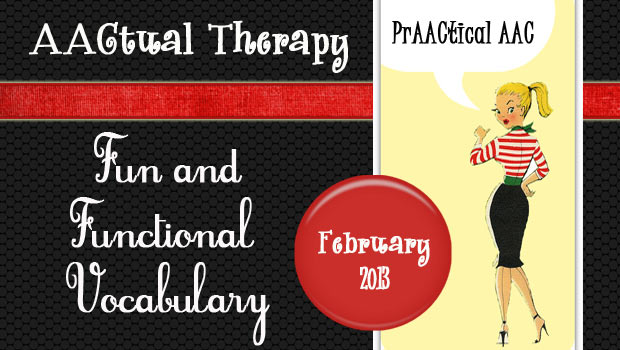
We are delighted to have Shareka Bentham back to share another post about the AACtual therapy she provides to little ones in Barbados. Last month, we followed her along to the zoo where her little friends got to generalize the language skills developed in therapy sessions. In this post, Shareka discusses her approach to something we all struggle with: selecting vocabulary that will both fun and functional. One of my biggest challenges in AAC is choosing good vocabulary targets, and working on vocabulary instruction for early communicators. By ‘good’ I mean targets which are functional for their everyday settings, representative, and most of all fun for children who are not only beginning communicators, but also beginning AAC users. I have become the AAC ‘specialist’ at a school for children with complex communication needs, so I generally have to cater to the communicative needs of children from the pre-communication to... [Read More...]
January 26, 2013
by Carole Zangari -
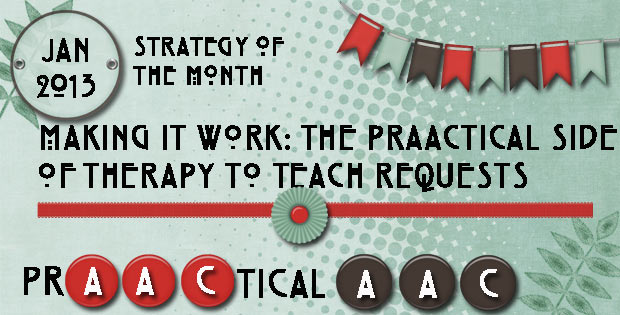
This month we’ve been talking about requesting and choicemaking, specifically how to teach it. Today, we’ll put it into a clinical context by talking about a hypothetical session that targets this skill, but also highlights other strategies. As you read about the materials, preparation, and script, look for how they incorporate strategies such as building specific communication opportunities {CO}, aided language input {ALI}, and expansions {EX}. The clinician also builds in repetition with variety so that there is sufficient opportunities for teaching and practice using multiple modes of communication. In this scenario, you’ll meet Jenna, a 5 year old with significant language difficulties secondary to Cri du Chat syndrome. Jenna’s communication system includes about a dozen manual signs (SIGN), 20-25 word approximations (SPEECH), a few gestures (GEST), some manual communication boards (COMM BD), and an iPad with a full-featured AAC app (iPAD). She also uses movement (MOVEMT), vocalizations (VOC), and... [Read More...]
January 19, 2013
by Robin Parker -

The January Strategy of the Month has focused on requesting and choice making. These are really fun goals to implement. They fall under the communication function that helps us meet our own needs (Behavioral Regulation). When we get what we want, there is a sense of control over the environment & we increase symbolic communication/language, and self-sufficiency. It’s all good. The assumption for all requests and choices is that the learner ‘likes’ what they have asked for. This is what makes the process so much fun, we get to do activities and have interactions that are positive and motivating. If only it was that easy… Sometimes it is not… But do not worry…there are plenty of solutions for common (and not so common) problems when teaching requesting and choice making. As always, set the stage for a positive TEACHING paradigm and then move to problem solving if necessary (and when it is... [Read More...]
January 12, 2013
by Carole Zangari -
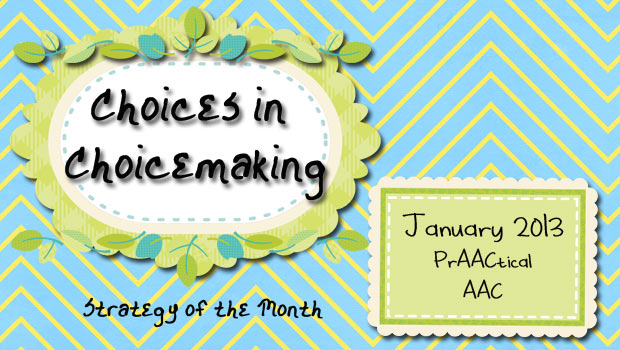
Choicemaking and requesting may be the most frequently targeted areas for beginning communicators who are starting out with their AAC systems. That makes sense for some learners because making choices is a very concrete focus for interaction and is loaded with motivational power. It seems pretty straightforward but, like anything else we do clinically, there are lots of decisions and choices to be made as we delve deeper into the process. How can we craft an AAC system that targets requesting for now, but also supports core language learning? For communicators who are at the earliest stages of making requests with AAC symbols, the strategy we discussed earlier this month or simple choice boards are a good starting point. But unless we quickly address where this is all going, the client will be strictly limited in their language learning. There are many ways to do this. Here is one approach.... [Read More...]
January 10, 2013
by Carole Zangari -
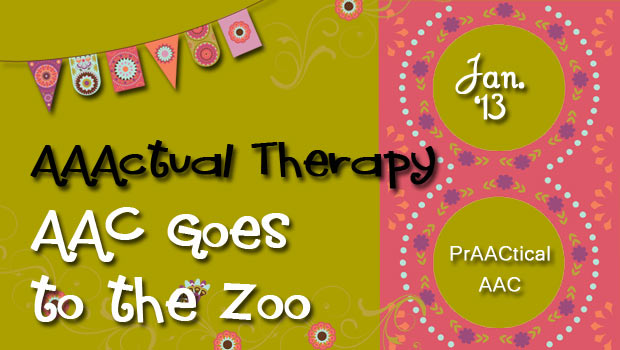
Welcome to AACtual Therapy, a new series on PrAACtical AAC that we’re undertaking in order to give you an up-close-and-personal look at SLPs who ‘do’ AAC. Each of these posts will feature one of our prAACtical friends, some of whom have been AAC interventionists for awhile and others who have come to it more recently. Each one is passionate about giving people a voice no matter what their age or ability level. They’ll be giving us a peek into an AAC therapy lesson that they use, and telling us about the strategies that make it successful. They’ll share a bit about the goals and objectives the lesson was designed to address, and what sorts of AAC their clients are using. Hopefully, we’ll see them in action Here’s what NOT to expect: Perfection. It doesn’t exist, so we don’t even bother looking for it. We’re featuring these clinicians because we want... [Read More...]
January 5, 2013
by Carole Zangari -
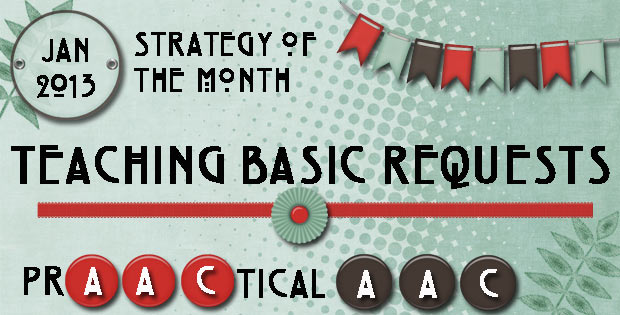
With the start of the new year, we thought it would be a good time to get back to basics. So this month, we’ll talk about the nitty gritty of teaching basic requesting to someone who is first learning to communicate using AAC. For learners who are not sending purposeful communication signals or those who seem unaware that communication involves interaction with another person, we think it makes sense to consider using the PECS curriculum. Why? Because the act of being assisted in physically giving a picture symbol to another person in exchange for a desired object can be an efficient way for someone to gain awareness of two critical principles. First, they learn that communication gives them the power to impact their environment. Secondly, the direct exchange highlights the fact that communication involves two people. As the PECS curriculum is already well established, its procedures will not be addressed... [Read More...]
December 22, 2012
by Robin Parker -
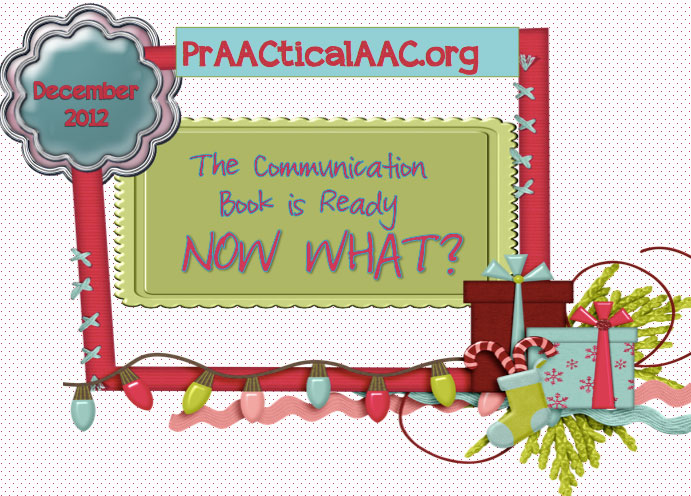
The Communication Book is Ready… Now What? The fun begins…. Yes, we really do think that TEACHING a learner to USE the communication book is FUN. We get to participate in lots of meaningful language experiences, we get to be creative, we get to watch language blossom, and we get to be surprised by the communication competence ALL of our learners show us after prAACtice, prAACtice, and for some more prAACtice . The best way to get started with communication book teaching is to begin by trying out different teaching tips, strategies, and resources and find out what works best. Each communication dyad (communicator & communication partner) is different so the combination of strategies that will work will vary but at the core of the teaching process, there should be fun, motivation, and of course progress. STRATEGIES and CONSIDERATIONS Aided Language Input (ALI)– We can not say enough about... [Read More...]









